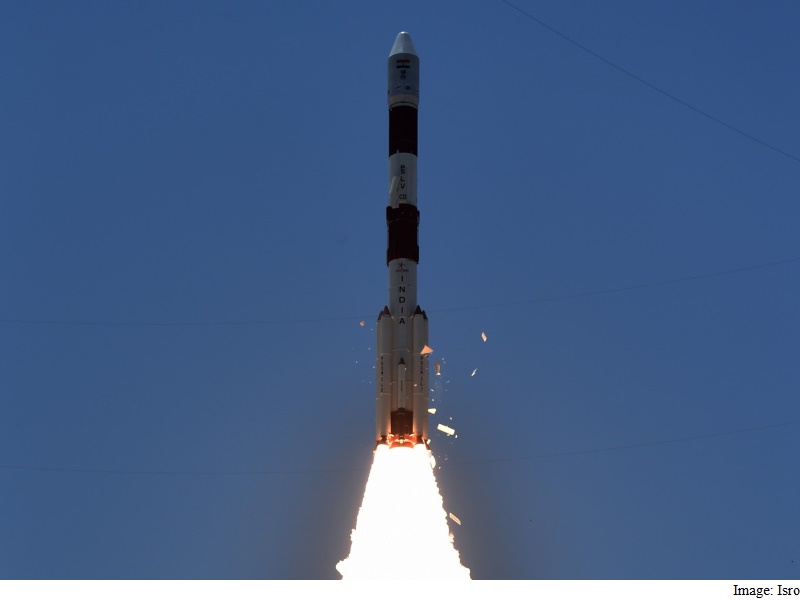- Home
- Science
- Science News
- Isro to Look at Possibility of Recovering Rocket Stage
Isro to Look at Possibility of Recovering Rocket Stage

"We are also looking at that programme," K.Sivan, director, Vikram Sarabhai Space Centre (VSSC) told IANS on the phone from Sriharikota in Andhra Pradesh.
The VSSC is a division of Indian Space Research Organisation (Isro).
Referring to US-based aerospace company SpaceX's attempts in this regard, Sivan said Isro too is planning like that.
SpaceX, with its two rockets - Falcon 9 and Falcon Heavy - offers satellite launch services.
A rocket stage comprises the engine, fuel and other systems.
The stages constitute the bulk of a rocket's cost and a saving on that will reduce the launch cost.
For instance, India's polar satellite launch vehicle (PSLV) is a four-stage rocket. It also has six booster engines strapped on the first stage.
The rocket is an expendable one, that is, nothing is recovered once it is launched.
So, recovering for instance the first PSLV stage means making it re-enter the atmosphere safely after it puts the other three stages up.
The outer shell of the stage should have sufficient heat-resistant materials. The stage should also be programmed to land at a specified location, preferably at the launch pad itself.
Sivan said recovery of the stage and using it again is completely different from the reusable launch vehicle (RLV).
He said developing a full-fledged RLV will take quite some time.
"We have to develop various technologies before finalising the specifications for our own RLV," Sivan said.
On May 23, Isro successfully took the first step in developing a RLV by successfully testing an aircraft like winged structure.
Called RLV-Technology Demonstrator HEX 01 mission, the winged structure which sat atop a rocket was released into the space at above 70km from the earth.
The winged structure returned and landed in the Bay of Bengal as originally planned.
However, the future of India's RLV depends on factors like its economic viability as compared to conventional expendable rockets; development of a powerful engine/stage to power that vehicle and also availability of funding for the project.
Meanwhile, Isro will soon be testing its air breathing engine.
Air-breathing engines use atmospheric oxygen and burn it with the stored on-board fuel to generate the onward thrust.
Conventional rockets carry both oxygen and chemical fuel on board.
"We will soon be testing - may be this June - our air breathing engine fitted to a sounding rocket," Sivan said.
Catch the latest from the Consumer Electronics Show on Gadgets 360, at our CES 2026 hub.
Related Stories
- Samsung Galaxy Unpacked 2025
- ChatGPT
- Redmi Note 14 Pro+
- iPhone 16
- Apple Vision Pro
- Oneplus 12
- OnePlus Nord CE 3 Lite 5G
- iPhone 13
- Xiaomi 14 Pro
- Oppo Find N3
- Tecno Spark Go (2023)
- Realme V30
- Best Phones Under 25000
- Samsung Galaxy S24 Series
- Cryptocurrency
- iQoo 12
- Samsung Galaxy S24 Ultra
- Giottus
- Samsung Galaxy Z Flip 5
- Apple 'Scary Fast'
- Housefull 5
- GoPro Hero 12 Black Review
- Invincible Season 2
- JioGlass
- HD Ready TV
- Laptop Under 50000
- Smartwatch Under 10000
- Latest Mobile Phones
- Compare Phones
- Vivo Y500i
- OnePlus Turbo 6V
- OnePlus Turbo 6
- Itel Zeno 20 Max
- OPPO Reno 15 Pro Mini 5G
- Poco M8 Pro 5G
- Motorola Signature
- Vivo Y50e 5G
- Lenovo Yoga Slim 7x (2025)
- Lenovo Yoga Slim 7a
- Realme Pad 3
- OPPO Pad Air 5
- Xiaomi Watch 5
- Huawei Watch 10th Anniversary Edition
- Acerpure Nitro Z Series 100-inch QLED TV
- Samsung 43 Inch LED Ultra HD (4K) Smart TV (UA43UE81AFULXL)
- Asus ROG Ally
- Nintendo Switch Lite
- Haier 1.6 Ton 5 Star Inverter Split AC (HSU19G-MZAID5BN-INV)
- Haier 1.6 Ton 5 Star Inverter Split AC (HSU19G-MZAIM5BN-INV)

















